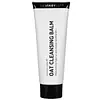What's inside
What's inside
 Key Ingredients
Key Ingredients

 Benefits
Benefits

 Concerns
Concerns

No concerns
 Ingredients Side-by-side
Ingredients Side-by-side

Prunus Amygdalus Dulcis Oil
Skin ConditioningCetearyl Alcohol
EmollientPEG-6 Caprylic/Capric Glycerides
EmulsifyingAvena Sativa Kernel Oil
Skin ConditioningCandelilla Cera
EmollientSilica
AbrasiveSorbitan Stearate
EmulsifyingTribehenin
EmollientPEG-60 Almond Glycerides
EmulsifyingAvena Sativa Kernel Flour
AbrasiveWater
Skin ConditioningBenzyl Alcohol
PerfumingPhenoxyethanol
PreservativeLecithin
Emollient1,2-Hexanediol
Skin ConditioningAscorbyl Palmitate
AntioxidantTocopherol
AntioxidantBiosaccharide Gum-4
Skin ConditioningHelianthus Annuus Seed Oil
EmollientPrunus Amygdalus Dulcis Oil, Cetearyl Alcohol, PEG-6 Caprylic/Capric Glycerides, Avena Sativa Kernel Oil, Candelilla Cera, Silica, Sorbitan Stearate, Tribehenin, PEG-60 Almond Glycerides, Avena Sativa Kernel Flour, Water, Benzyl Alcohol, Phenoxyethanol, Lecithin, 1,2-Hexanediol, Ascorbyl Palmitate, Tocopherol, Biosaccharide Gum-4, Helianthus Annuus Seed Oil
Helianthus Annuus Seed Oil
EmollientRicinus Communis Seed Oil
MaskingHydrogenated Rapeseed Oil
EmollientGlyceryl Citrate/Lactate/Linoleate/Oleate
EmulsifyingPolyglyceryl-3 Caprate
EmulsifyingPolyglyceryl-3 Polyricinoleate
EmulsifyingHelianthus Annuus Seed Wax
Skin ConditioningTocopherol
AntioxidantHippophae Rhamnoides Seed Oil
Skin ProtectingAscorbyl Palmitate
AntioxidantOlea Europaea Fruit Oil
MaskingAnigozanthos Flavidus Flower Extract
AntiseborrhoeicRosmarinus Officinalis Leaf Extract
AntimicrobialCeramide Ng
Skin ConditioningHelianthus Annuus Seed Oil, Ricinus Communis Seed Oil, Hydrogenated Rapeseed Oil, Glyceryl Citrate/Lactate/Linoleate/Oleate, Polyglyceryl-3 Caprate, Polyglyceryl-3 Polyricinoleate, Helianthus Annuus Seed Wax, Tocopherol, Hippophae Rhamnoides Seed Oil, Ascorbyl Palmitate, Olea Europaea Fruit Oil, Anigozanthos Flavidus Flower Extract, Rosmarinus Officinalis Leaf Extract, Ceramide Ng
 Reviews
Reviews

Ingredients Explained
These ingredients are found in both products.
Ingredients higher up in an ingredient list are typically present in a larger amount.
Ascorbyl Palmitate is created by combining pure Vitamin C and palmitic acid. It is an antioxidant and helps reduce hyperpigmentation.
This ingredient is a more stable version of Vitamin C, meaning it does not disintegrate as quickly when exposed to sunlight. However, studies show it does not penetrate skin as well as pure Vitamin C.
Ascorbyl Palmitate is oil soluble.
Read more about other types of Vitamin C:
Learn more about Ascorbyl PalmitateHelianthus Annuus Seed Oil is the oil derived from the seeds of a Sunflower. Sunflower seed oil is non-fragrant. It is an emollient, meaning it helps to soften the skin.
Sunflower seed oil contains many fatty acids. The fatty acids found in sunflower seeds include (from highest amount to least): linoleic acid, myristic acid, palmitic acid, stearic acid, arachidic acid, oleic acid, and linolenic acid.
These fatty acids help the skin create ceramides. Ceramides play a role in repairing the skin barrier.
Helianthus Annuus Seed Oil helps moisturize the skin. This in turn helps the skin look more rejuvenated and smoother.
Sunflowers are rich in vitamin E.
Historians believe Indigenous cultures of North America domesticated sunflowers before corn. Thus they relied on sunflower oil for a variety of uses. One such use is moisturizing skin and hair.
Sunflower seed oil may not be fungal acne safe. We recommend speaking with a professional if you have any concerns.
Learn more about Helianthus Annuus Seed OilTocopherol (also known as Vitamin E) is a common antioxidant used to help protect the skin from free-radicals and strengthen the skin barrier. It's also fat soluble - this means our skin is great at absorbing it.
Vitamin E also helps keep your natural skin lipids healthy. Your lipid skin barrier naturally consists of lipids, ceramides, and fatty acids. Vitamin E offers extra protection for your skin’s lipid barrier, keeping your skin healthy and nourished.
Another benefit is a bit of UV protection. Vitamin E helps reduce the damage caused by UVB rays. (It should not replace your sunscreen). Combining it with Vitamin C can decrease sunburned cells and hyperpigmentation after UV exposure.
You might have noticed Vitamin E + C often paired together. This is because it is great at stabilizing Vitamin C. Using the two together helps increase the effectiveness of both ingredients.
There are often claims that Vitamin E can reduce/prevent scarring, but these claims haven't been confirmed by scientific research.
Learn more about Tocopherol